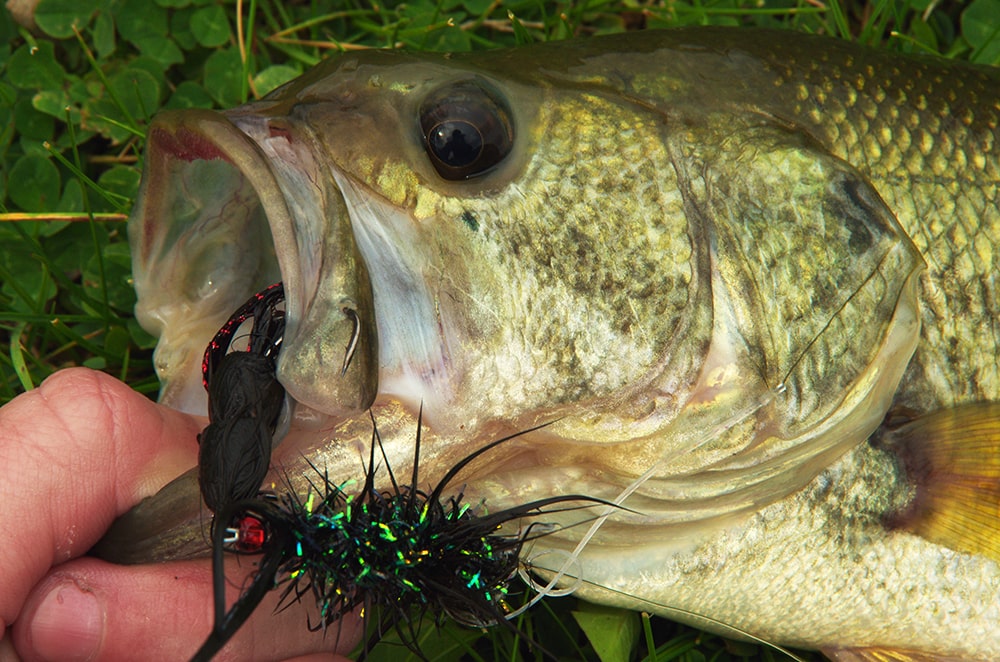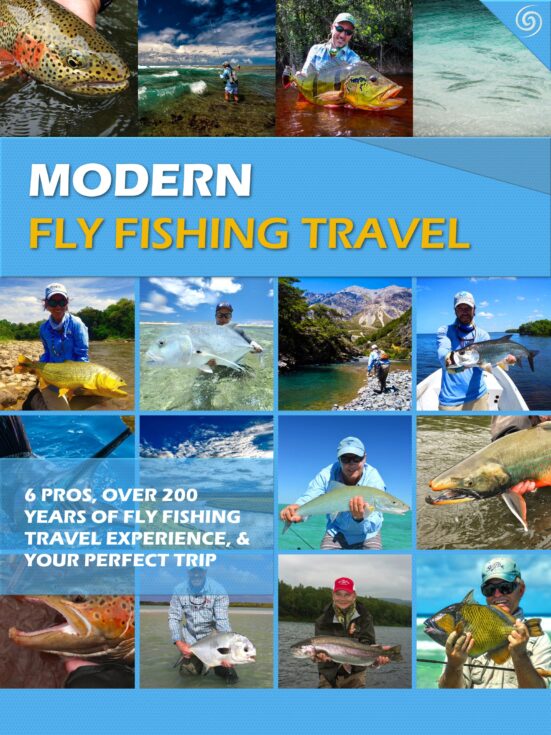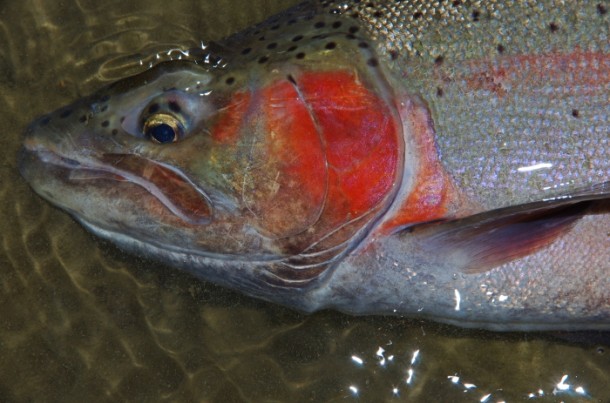Fly fishing for bass has become extremely common. This stands to reason because virtually all of the states in the United States and most provinces of Canada have bass species that fly anglers can catch quite easily.
The main species are the sunfish: largemouth bass, smallmouth bass, and spotted bass. There are also the “true bass” species: striped bass, hybrid striped bass, and white bass. Then, you have some rare species like the Guadalupe and yellow bass.
This article will cover the bass species in the two major classes: the sunfish and the true bass, and it is an introduction to fly fishing for bass. You can find individual articles on some of the species within this article.
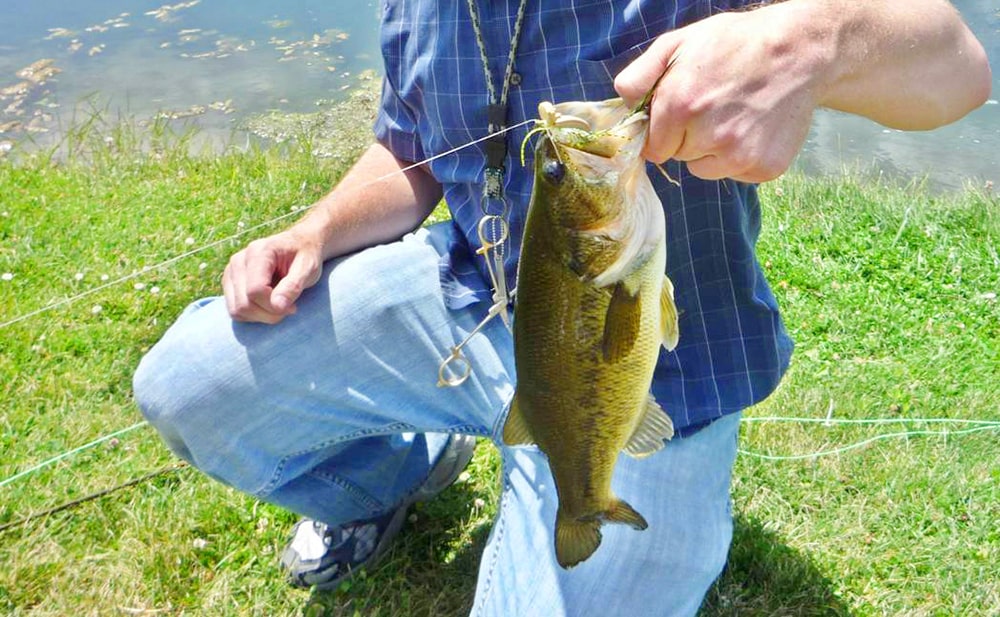
FLY FISHING FOR BLACK BASS/SUNFISH BASS
The first group of bass comprises the largemouth bass, smallmouth bass, spotted bass, and rock bass. It also includes crappie, bluegill, and the smaller sunfish, like redear, pumpkinseed, etc.
The sunfish family has an incredibly diverse diet. This is largely due to the evolution of this species and the niches within a given body of water that they have inhabited. For example, these bass will encounter frogs, crayfish, snakes, minnows, salamanders, ducklings, insects, leeches, small mammals, and other sunfish regularly.
Their bodies are also fairly wide, and they often use ambush as their preferred method to catch prey. Smallmouth, and to a lesser extent spotted bass, will also move into open-water feeding environments, but they still maintain their tendency to eat everything.
Because of this tendency, they use cover and structure to ambush their prey and will often be found waiting in ambush spots. They will also have no problem feeding during the hottest times of the day, staying true to their namesake.
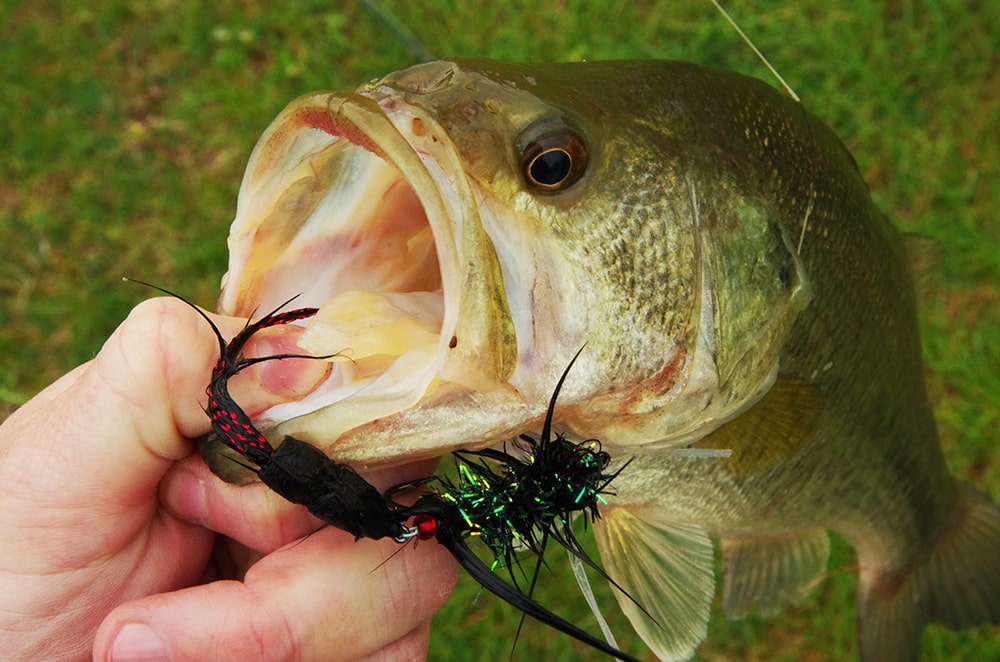
FLY FISHING FOR LARGEMOUTH BASS
There is no question that the largemouth bass is the most popular game fish in North America, and possibly the world. Almost every state has largemouth bass. Largemouth bass are usually the easiest of all bass species to find because you can find them in any pond, ditch, canal, lake, reservoir, and many slower-moving rivers.
The United States probably has the best largemouth bass fishing in the world. California holds 20 of the top 25 largemouth bass ever caught, while Florida adds one or two here as well. Almost every state has one or two special spots where tons of largemouth bass can be found. Some of these places are for huge numbers of small to medium fish, but some also have the potential to produce humongous bucketmouths.
Largemouth bass fly fishing is also extremely popular, and most people, I would wager, think of largemouth bass when you say “bass fly fishing.” They are my least favorite of all bass species to pursue and catch, perhaps tying with spotted bass, which are similar in a lot of respects.
Largemouth bass are primarily ambush feeders, so they are almost always synonymous with cover. Bass anglers with conventional gear require ultra weedless lures to catch largemouth in many cases, and fly anglers often struggle to match these weedless presentations.
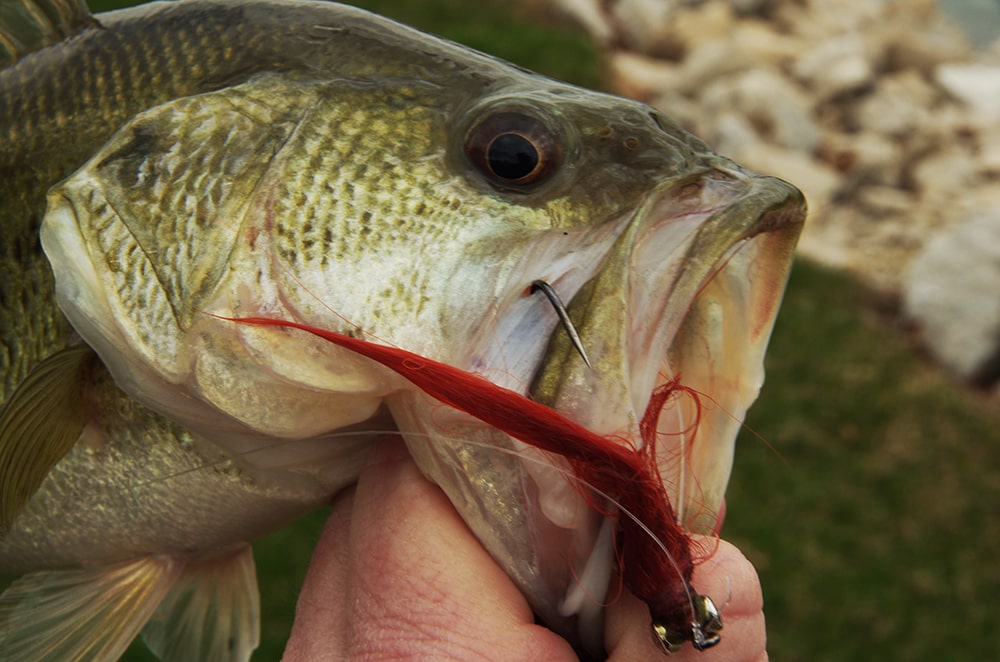
Both fly anglers and conventional anglers can use an unbelievably diverse set of flies and lures because the largemouth bass’s diet is so diverse. That is one thing about largemouth that is quite enjoyable; they eat big flies and huge prey items. That doesn’t mean you have to fish big at all, and in fact, flies in some pressured waters or at certain times of year will catch some big fish on small damsels and even carp flies, like the Backstabber.
Largemouth feed on both topwater and subsurface flies. Larger poppers and divers are good options for summer, while almost any large subsurface flies work at other times. As far as which subsurface patterns you should use and in what situations, it comes down to mainly how aggressive the fish are and how much water you’re covering.
If you’re covering a lot of water, you’ll use a more active fly like a Clouser, Hollow Fleye, Game Changer, Double Deceiver, Swingin’ D, etc. This may also include topwater flies like Umpqua’s Diving Frog, Ron Dong Crease Fly, Pole Dancer, or a Double-Barrel popper.
If the largemouth are negative or you know right where they are, you’ll fish slow and deep normally. Flies like the Bendback, Equalizer, Bottoms Up, thinly-tied, longer Clousers, Chocklett’s Changer Craw, and Ehler’s Grim Reaper are excellent for doing finesse or subsurface fly fishing for largemouth bass.
The best approach to fishing is to watch and read as much on general tackle bass fishing as possible. This is the most advanced and competitive fishing on planet earth. Apply their approaches to your bass fly fishing, and you’ll consistently catch fish.
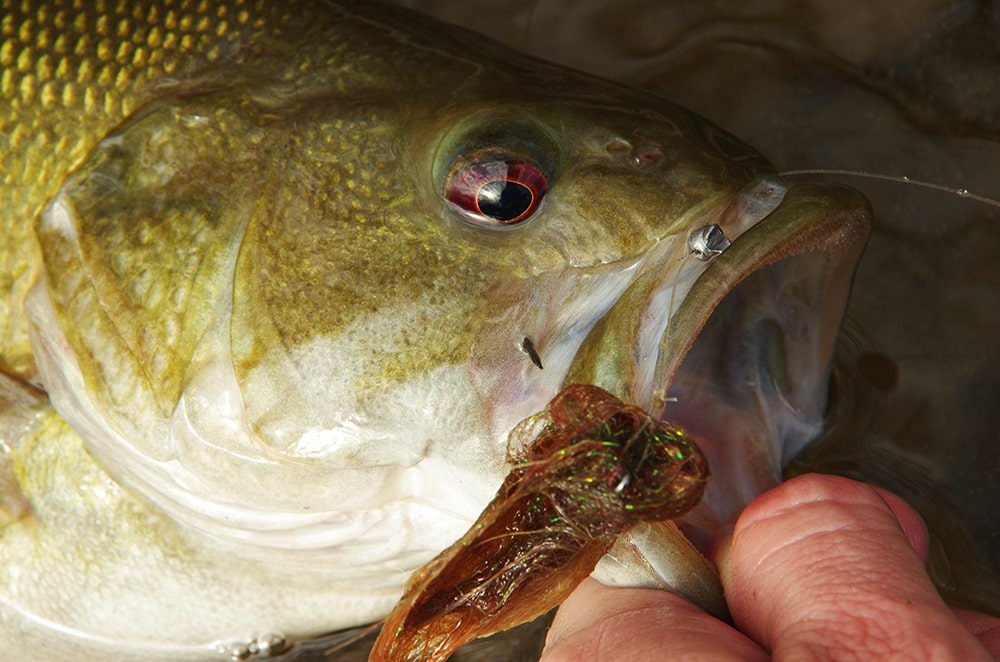
FLY FISHING FOR SMALLMOUTH BASS
Smallmouth bass are one of my favorite bass species to fly fish for, period. They’re awesome fighters and are about as perfect a species for fly fishing as could be imagined. They even eat bugs if you can’t relinquish the entomology aspect of fly fishing.
All of the top 25 largest smallmouth have come from the United States, and 13 of these have come from Tennessee. If you live in the East or Midwest, or even parts of the South, you’re blessed with a huge abundance of rivers that are filled with smallmouth. The Great Lakes also provide wading opportunities at certain times of the season for some enormous smallmouth. In addition to this, smallmouth will pour into the rivers from the Great Lakes in spring, so you can catch 3 to 6-pound smallmouths while fishing for steelhead.
Fly anglers often ignore reservoirs and lakes in the East and Midwest because of the number of rivers around them. Some do get out and pursue smallmouth bass on the fly in lakes and reservoirs, particularly in Canada, which has incredible fly fishing for smallmouth, particularly in Ontario.
If you live in the West, there are a few rivers that provide a similar experience to the East, particularly in Oregon. However, most of the time, reservoirs and some lakes provide your best shot at catching smallmouth on the fly.
Prespawn, spawn, and fall bring the fish into the shallows, which allows a fly angler with a kayak or pontoon boat to sight-fish to these guys. You can still access these fish during the summer as well in many of these reservoirs, particularly if they have steep drop-offs right along the shore.
Mornings and evenings are your best bet as the fish can adjust vertically quite easily and will feed on the steep rocky banks and/or rocky flats. Note that this is often different from Eastern rivers, particularly small to medium ones, which actually are better as the sun comes up. In the West, any watercraft will help you get in the game for smallmouth.
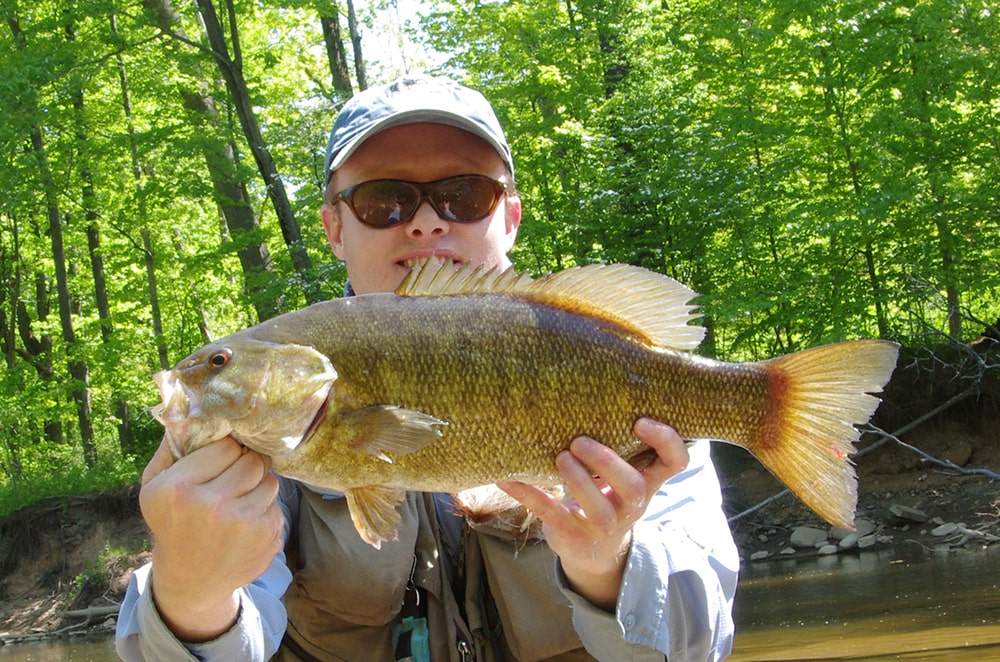
Smallmouth feeding tactics and smallmouth fly selection are very much like largemouth above. Downsize just a tad for smallmouth, however, and don’t be afraid to go super small in some finesse situations.
If you’re covering a lot of water for smallmouth with flies, again you’ll use a more active fly like a Clouser (particularly in larger bodies of water), Hollow Fleye (craft fur and bucktail), Game Changer (craft fur, feathered), Double Deceiver, Swingin’ D, etc. This may also include topwater flies like Umpqua’s Diving Frog, Ron Dong Crease Fly, or a Double-Barrel popper.
If the smallmouth are negative or you know right where they are, you’ll fish slow and deep normally, often sight-fishing. Flies like the Equalizer, Chocklett’s Changer Craw, small Clousers, and PC Goby are excellent for doing finesse or subsurface fly fishing for smallmouth bass.
Take the same approach as you would with largemouth bass by learning about what conventional tackle anglers are doing, particularly pro bass anglers.
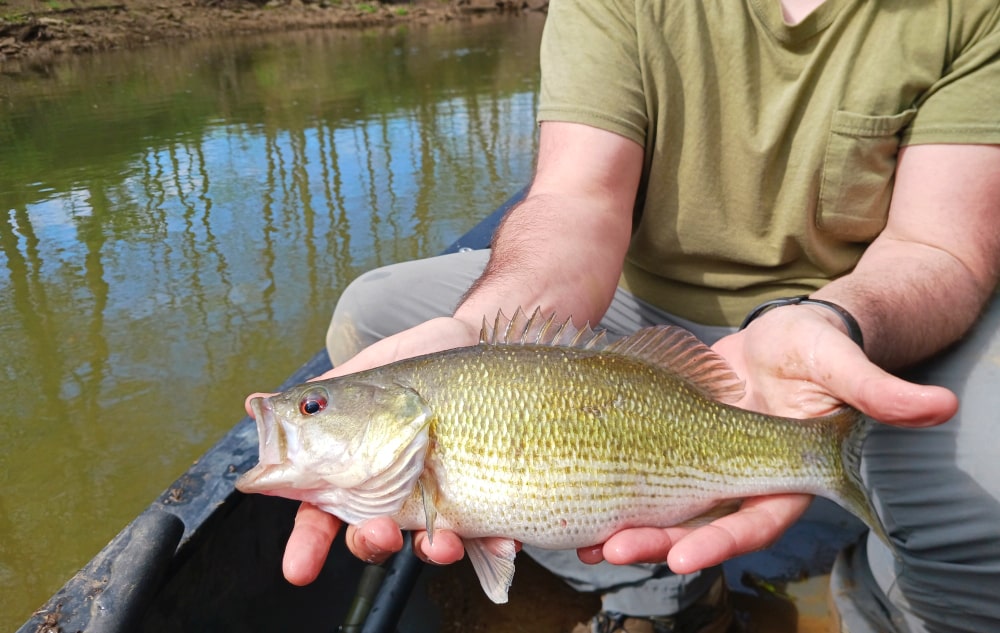
Photo: Lou Uecker
FLY FISHING FOR SPOTTED BASS
Spotted bass are really two species: northern spotted bass (rarely over 5 pounds) and Alabama bass (double digits, mainly in California). They are similar to each other, and most people don’t distinguish them, as scientists for a long time considered them to be the same species. For the purposes of this article, we will consider them the same fish, spotted bass.
These bass are some of the most aggressive and tough bass that you’ll encounter. They are somewhat small in most cases, but in California, you get some absolute monsters—these are actually Alabama bass. Outside of California, you can plan on your average-sized spotted bass being smaller than an average smallmouth in most cases.
Spotted bass behave more like smallmouth than they do largemouth. In fact, spotted bass/Alabama bass will often cause local bass populations to go down because of their voracious nature. Largemouth can often survive this because they move to more highly vegetated areas of the lake or reservoir that spotted bass don’t populate in high numbers. In other words, largemouth bass will sometimes inhabit certain areas that spotted bass will not.
Flies and tactics for spotted bass are primarily the same as you would use for smallmouth and largemouth, but because they are on average a little smaller, you can often use flies you would use for a population of slightly smaller smallmouth bass. This would obviously change if you were pursuing the larger populations of spotted bass (Alabama bass) in California.
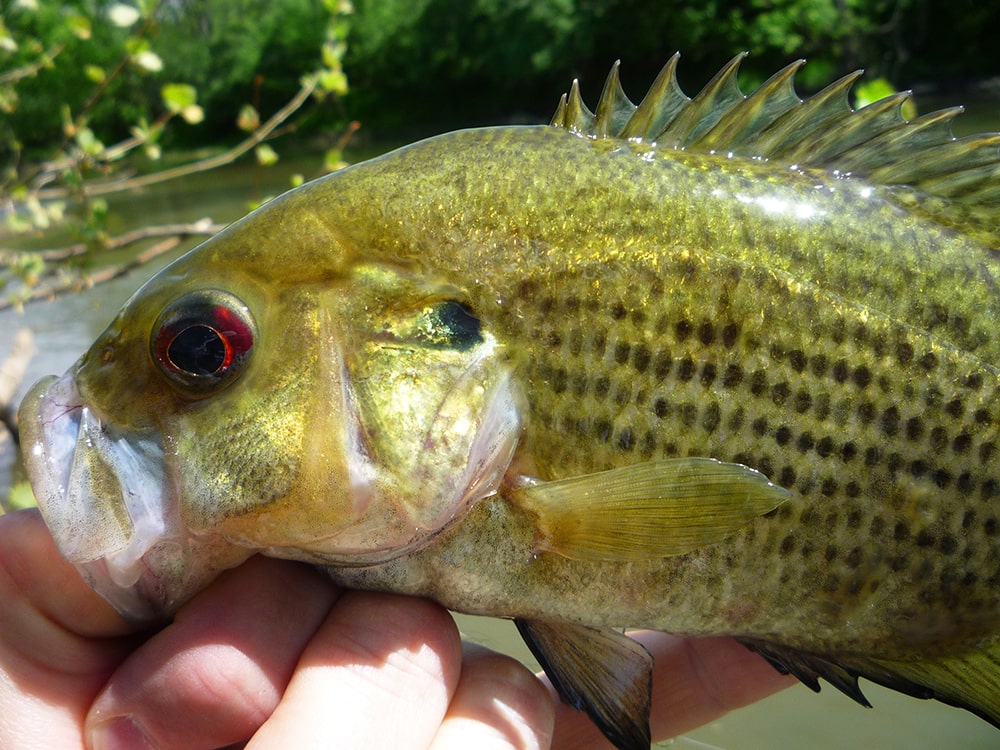
FLY FISHING FOR ROCK BASS
A bonus bass is the rock bass. Rock bass are the true transition from the panfish version of sunfish to the bass species. They look exactly like you would expect a bluegill crossed with a smallmouth bass would look. Rock bass inhabit many bodies of water in the East, Midwest, and Southern United states and many of the Eastern Provinces of Canada.
Fly fishing for rock bass isn’t really something I have ever heard anyone doing. Rock bass are almost always bycatch when you’re fly fishing for smallmouth, bluegill, crappie, or largemouth.
If you ever wanted to fly fishing specifically for rock bass, you would use sized-down smallmouth flies or sized-up bluegill flies.
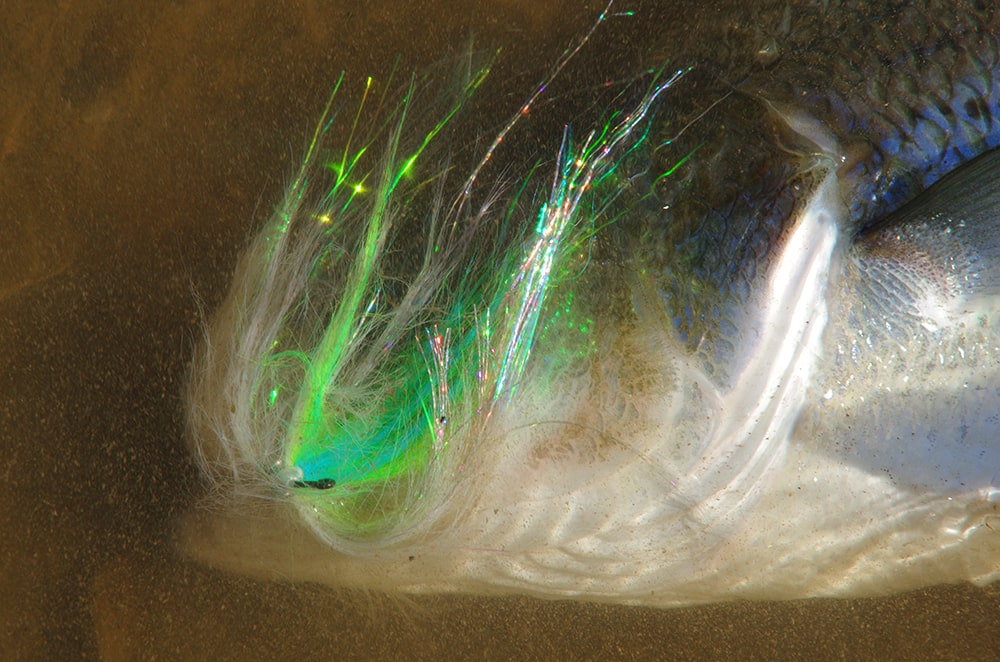
FLY FISHING FOR TEMPERATE BASS/TRUE BASS
Temperate bass, from the family moronidae, portray many differences from the sunfish bass species. There are 4 main tendencies that these bass have that make them unique to the fly angler.
First, they are highly migratory. In fact, striped bass are anadromous moving from fresh water to salt water like salmon do. All of the temperate bass species are anadromous in that they move into rivers to spawn. Besides this, they move extensively in the water systems they inhabit, both throughout the day and throughout the season.
Second, temperate bass have very different feeding tendencies from the sunfish bass species. Because it is the nature of temperate bass to migrate, they follow large schools of minnows regularly. Find the bait, and you’ll find the fish. That means that the temperate bass can be much more inclined to feed in open water. They will use structure and cover to corral bait, but they look for large schools of baitfish and make it a point to follow them, feeding when they have an ideal chance.
Because of this, they also become somewhat selective on the size and appearance of the flies you throw. You often need to match the hatch for these bass since they get in the pattern of munching on large schools of bait.
Third, temperate bass are highly social, living almost exclusively in schools. Fly fishing for these bass does not entail making pinpoint casts to pieces of cover normally. You’re more likely to fan cast trying to cover water attempting to locate a school bass.
Fourth, they are often sensitive to sunlight, and normally prefer lowlight scenarios for feeding, particularly at dusk and dawn. They will feed during the day, specifically white bass, but you can bet that you’ll have great success at these lowlight time periods.
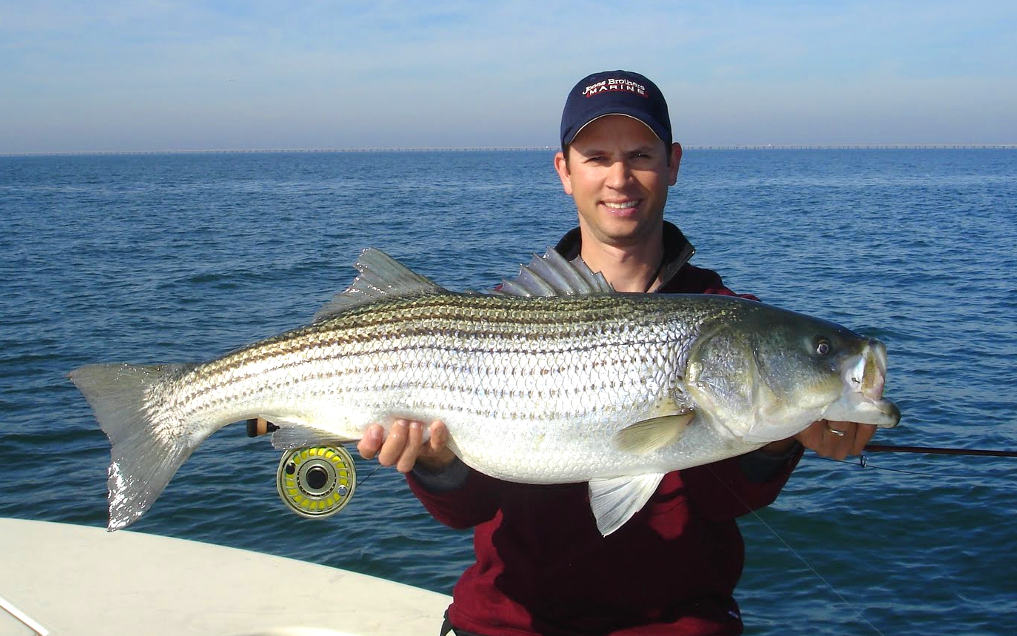
Photo: Captain Chris Newsome
FLY FISHING FOR STRIPED BASS
Fly fishing for striped bass is extremely popular, particularly on both coasts. Stripers are natively an anadromous saltwater species from the Atlantic Ocean, but they have been successfully introduced to the West Coast, where they are extremely popular, specifically in California and the Delta fishery and surrounding area.
Striped bass are also found in tons of freshwater impoundments and lakes, and many high-quality fisheries exist throughout the United States, particularly in the South and Midwest, with a few Western and Eastern fisheries thrown in for good measure.
Because stripers are anadromous, they also show up in many different river systems. This makes them accessible to fly anglers that are actually wading, and this is also the case for many Eastern coastal fisheries, where fly anglers fish from shore. A watercraft of some sort will help a ton in most scenarios, however.
Stripers primarily feed on minnow species, but they also feed on crabs, worms, squid, and shrimp in ocean and estuary environments. Like the other species of temperate bass, they often get somewhat selective on shape and size of fly when they are feeding on a particular minnow species, so having a selection of sizes of minnow patterns is critical to consistently landing stripers on fly.
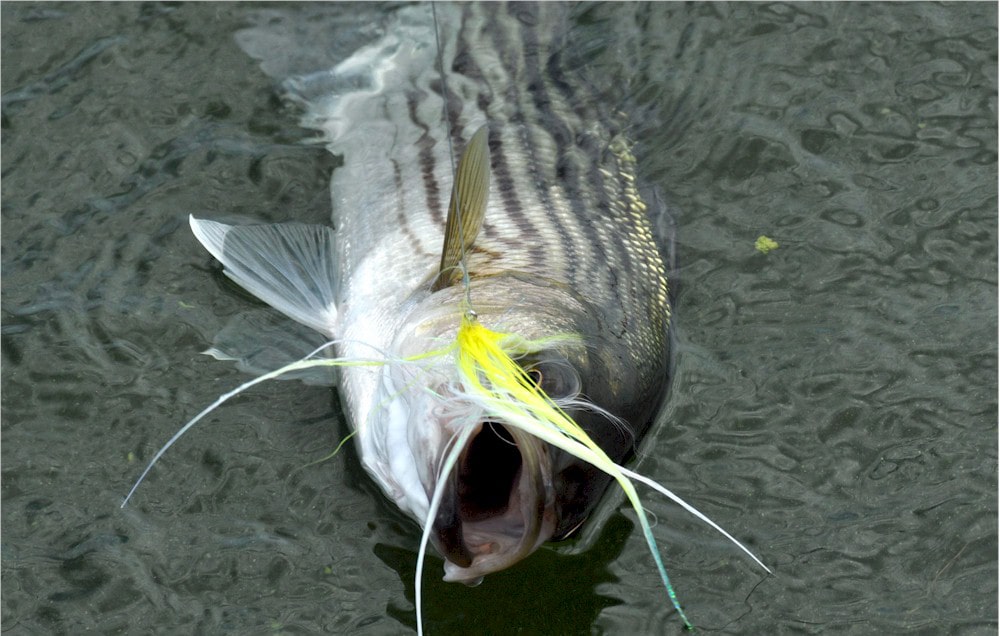
As far as flies go, there are interesting traditions on both the East and West Coasts, but they all work on both coasts. On the East Coast, Bob Popovics’ flies are extremely popular. These are the Hollow Fleye, Bulkhead, Semper Fleye, Surf Candy, Jiggy Fleye, and Bob’s Banger. Other prominent tyers are Johnny King, Steve Farrar, and Dave Skok.
On the West Coast, Dan Blanton and Charlie Bisharat have contributed greatly to the flies of that region. These include Flashtail Clousers and Flashtail Whistlers. Bisharat’s patterns are the Airhead, Spot-on Baitfish, and the Pole Dancer. Lee Haskin is also another prominent tyer.
Use these patterns, in addition to Clousers tied in different ways, and you’ll be set on fly patterns for striped bass.
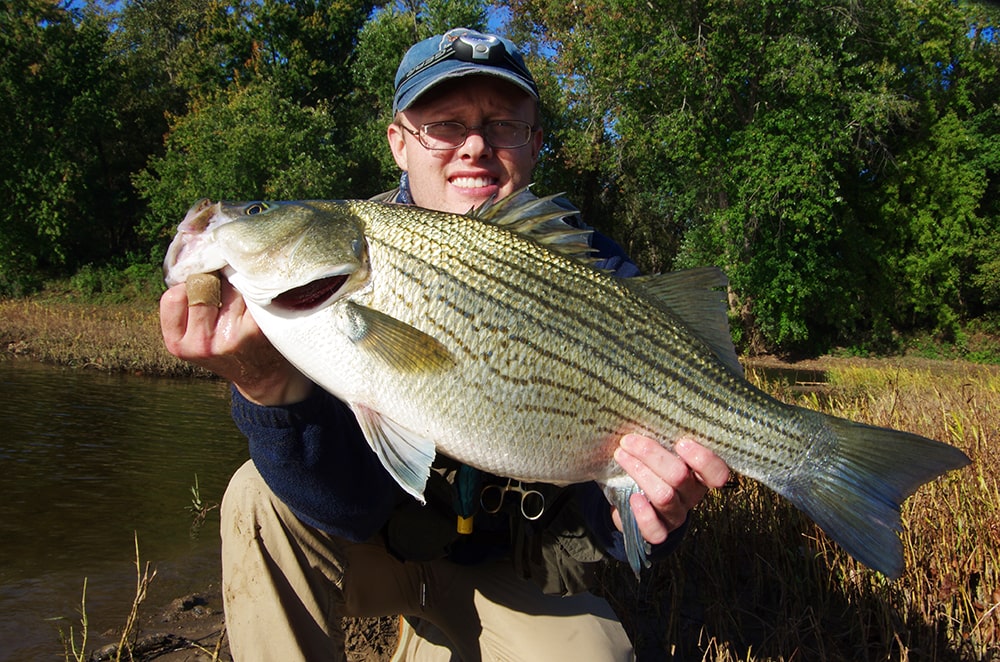
FLY FISHING FOR HYBRID STRIPED BASS
Hybrid striped bass (hybrids, wipers) are my favorite species to catch on a fly in fresh water—when you can catch them. They are a mix of a striped bass female and a white bass male and are therefore sterile in the vast majority of cases.
They are the most sensitive to light of any species of bass that I’ve pursued, and you normally catch them at dawn and dusk. Like the other true bass, they are also a highly social species that is almost always in a school. Because of this, it’s often a feast or famine experience.
Hybrid striped bass are insanely powerful fish, the strongest of the bass species. They, like the other true bass, are much more migratory than the sunfish species. Because of this, they have much more stamina and speed. If you have never seen your backing in fresh water, latch into a nice hybrid striped bass in a river, and that will change everything.
When fly fishing for hybrids, you will find them in lakes/reservoirs and in rivers, which makes them a great species for fly anglers. They will use structure and cover to push bait into a corner, and this is an important place to look when pursuing hybrids. Current is also a great way for them to confuse and corral baitfish. For this reason, dams and locks are a great place to look for hybrids.
Hybrid striped bass can become selective as they follow around or corner schools of bait. If the bait is small, they will key on these, which gives fly anglers an advantage if the bait is super small. They will also annihilate larger flies in many cases, and when you get on a school of large fish, over 8 pounds, it is unlike anything you will experience in fresh water.
Good flies are Clousers from 2 to 6 inches and EP Shad flies. They will also take top-water flies, like the Ron Dong Crease Fly, the Pole Dancer, and Double Barrel Poppers.
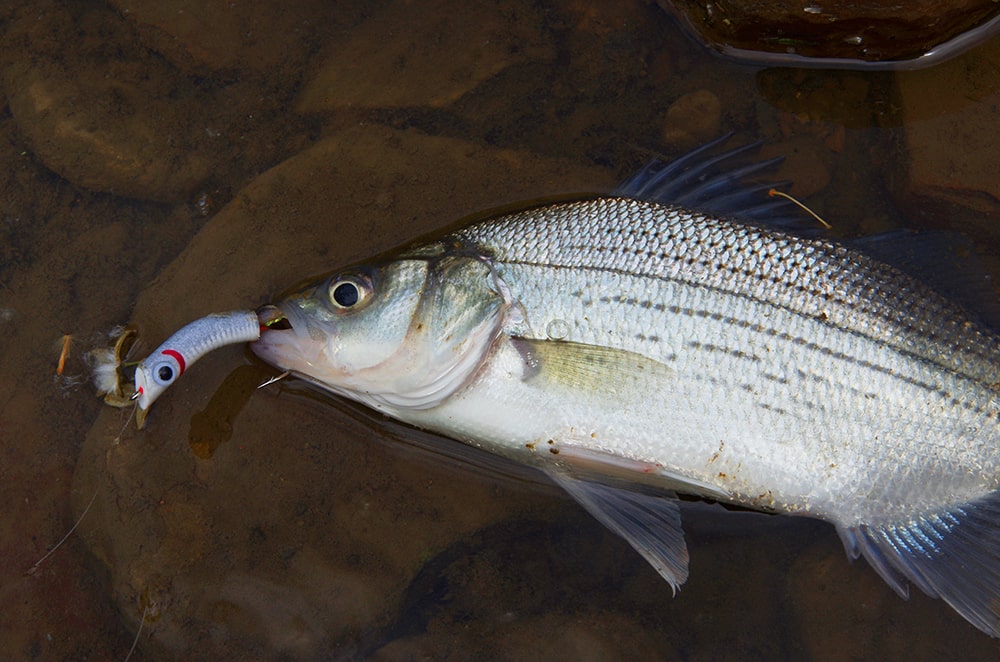
FLY FISHING FOR WHITE BASS
If you think bluegill are fun, you’ll love white bass. White bass are the smallest of the major bass species we pursue (not including rock bass), but they make up for it with a voracity that is frightening for any minnow species that might encounter a school of ravenous white bass.
You can catch white bass in both stillwaters and rivers, and when they come into rivers in the spring, the action is just plain stupid when you catch it right.
White bass fly fishing is also a great way to introduce a kid to fly fishing with an active retrieve. You can take turns casting and catching, or you can simply fish together, hole hopping up the river.
White bass are very similar to hybrid striped bass, except they are much more active during the sunny times of the day or on sunny days in general. In fact, you’ll often catch white bass in the bright sun, and you’ll also catch white bass and hybrid striped bass in the same areas of the river, catching a hybrid on one cast and a white bass on the next.
Flies are simple, a white Craft Fur Hollow Fleye #4 or a smallish Clouser are often all it takes. Throw in a Wiggle Minnow, and you should be set. White and chartreuse are great color combos for your white bass flies.
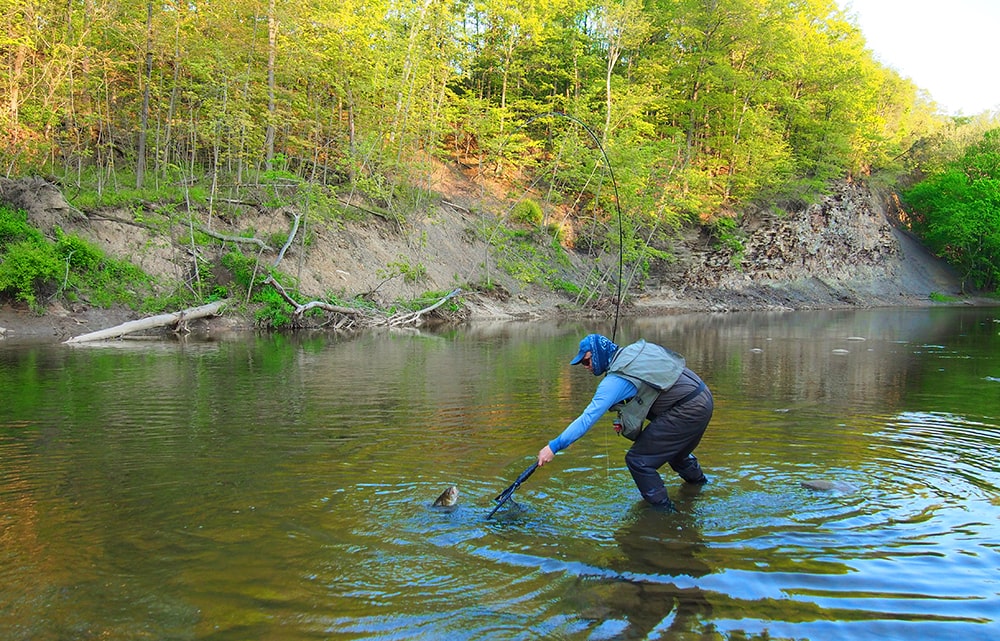
Photo: Jeff Liskay
BASICS OF EQUIPMENT
It is very hard to make generalizations about bass equipment because it varies so much. You have stripers on one end, which can weigh over 50 pounds, and rock bass, which normally weigh under a pound. With that in mind, we can put bass equipment into three main classes: 1) stripers, hybrids, and largemouth; 2) smallmouth; and 3) white bass and spotted bass.
ROD WEIGHTS
For stripers, hybrids, and largemouth, you normally use a rod from a 7 to 10 weight, depending on the fly, conditions, and casting distance. You can even use a 6 weight in many cases. For smallmouth, normally we use 6 to 8 weights, but 5 weights are sometimes used. For white bass and spots, we use 5 to 6 weights normally.
LINES
Lines vary tremendously, from floating lines to full sinking lines, depending on the body of water that you’re pursuing the bass on. A full sinking intermediate is a very good all-round fly line, and you need a floating line for poppers. On larger bodies of water, you’ll probably use a shooting head style fly line, like RIO’s Outbound lines. Sink tips are also very good for rivers in particular.
LEADERS AND TIPPETS
Leaders and tippets normally range from 10 lb. to 20 lb., and sometimes heavier for stripers. The size of your fly is the most important thing to consider here. The bigger the fly, the larger the diameter of your leader and tippet.
BASS FLY FISHING: SO MANY OPTIONS
Fly fishing for bass is something that all fly anglers should do. If you live in The United States, you’re living in the world hub of bass fishing. You more than likely have a bass species swimming in a pond, river, or reservoir within ten miles of where you live, and you might just find an incredible fly fishing experience you never knew existed. You might not be ready to give up your ClackaCraft for a Ranger, but you might be missing a new facet of fly fishing that will inform your trout fishing.
Don’t underestimate the rugged beauty and fertility of a bass’s environment as well. I’ve seen smallmouth bass rivers that looked like an ocean reef just teaming with huge schools of minnows.
You also have variety. You can visit pristine wilderness or find a largemouth in the pond across from your house. We all want to fly fish more, make sure your getting in your quota of yearly fly fishing for bass.

